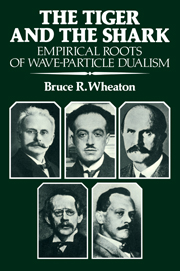Book contents
- Frontmatter
- Contents
- Foreword by Thomas S. Kuhn
- Preface
- Notes on sources
- 1 Introduction
- Part I The introduction of temporal discontinuity, 1896–1905
- Part II Ionization and the recognition of paradox, 1906–1910
- Part III Seeking an electrodynamic solution, 1907–1912
- Part IV Interference of x-rays and the corroboration of paradox, 1912–1922
- 8 Origins of x-ray spectroscopy
- 9 Quantum transformation experiments
- Part V The conceptual origins of wave–particle dualism, 1921–1925
- Epilogue: The tiger and the shark
- Bibliography
- Index
9 - Quantum transformation experiments
Published online by Cambridge University Press: 04 August 2010
- Frontmatter
- Contents
- Foreword by Thomas S. Kuhn
- Preface
- Notes on sources
- 1 Introduction
- Part I The introduction of temporal discontinuity, 1896–1905
- Part II Ionization and the recognition of paradox, 1906–1910
- Part III Seeking an electrodynamic solution, 1907–1912
- Part IV Interference of x-rays and the corroboration of paradox, 1912–1922
- 8 Origins of x-ray spectroscopy
- 9 Quantum transformation experiments
- Part V The conceptual origins of wave–particle dualism, 1921–1925
- Epilogue: The tiger and the shark
- Bibliography
- Index
Summary
Where does the ejected electron get its kinetic energy when its separation from the light source becomes so great that the light intensity almost completely vanishes?
The same x-ray spectroscopic techniques that led to the identification of the atomic origin of x-ray spectra also offered means to test the localization of energy in the radiation. In the second decade of this century, x-ray spectrometers used as monochromatizers provided more purely defined x-rays than had been available from natural characteristic radiation. This, coupled with techniques to determine the kinetic energy of secondary electrons, provided opportunities for precise testing of the quantum transformation relation, E = hv. These experiments form the subject of this chapter.
We are primarily concerned here with the absorption of radiation, not with its emission. To be sure, the quantum regulation of the emission of radiant energy has no classical explanation; yet there is no electromechanical inconsistency implied in the creation of a spherical wave containing a definite amount of energy. It is the inverse case that causes real difficulty. How can that quantum of spherically radiating energy concentrate its full power on a single electron? For this reason, verification of the quantum relationship for emitted radiation lies outside our direct concerns. The Franck-Hertz experiments beginning in 1912, for example, demonstrated the quantum nature of energy transfer, but they did little to encourage acceptance or even consideration of the lightquantum. On the other hand, the experiments detailed here that verified the quantum nature of the absorption of light and x-rays gave substance to the lightquantum hypothesis because they verified the particlelike transfer of radiant energy to matter.
Information
- Type
- Chapter
- Information
- The Tiger and the SharkEmpirical Roots of Wave-Particle Dualism, pp. 233 - 260Publisher: Cambridge University PressPrint publication year: 1983
